DiBenedetto E. Degenerate Parabolic Equations
Подождите немного. Документ загружается.

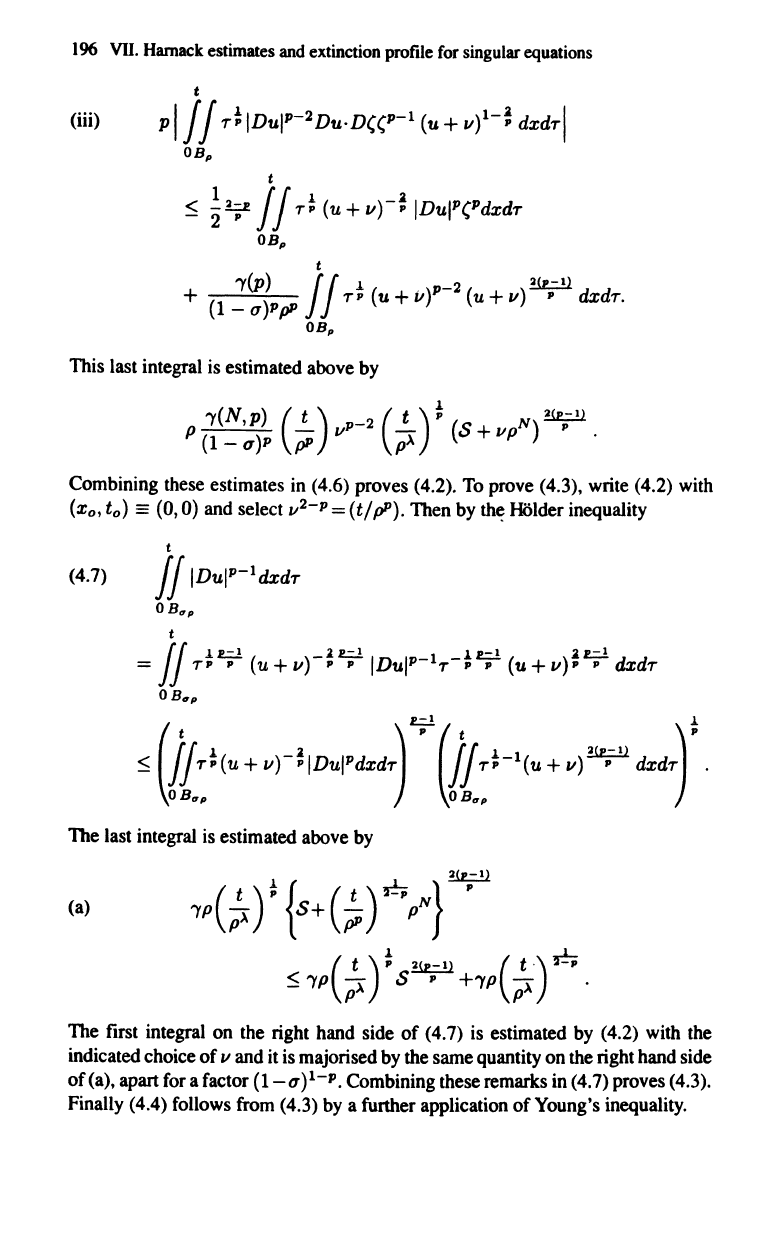
196
VII.
Harnack
estimates and extinction profile
for
singular equations
t
(iii)
p I I I
'T~
I
Du
l,,-2
Du·D((,,-l
(U
+
1I)1-~
dxd'Tl
OBp
t
~
~¥
I I
'T~
(U
+
II)-~
IDul"("dxd'T
OB
p
t
+
(1
2~;"pI'
11'1';
(u + v),,-2
(u
+
II)
2('1'-1)
dxd'T.
OBp
This last integral is estimated above by
p "Y(N,p)
(.!.-)
11,,-2
(.!.-)
~
(8
+ IIpN)
2(,;1)
•
(1
-
U)"
pi'
p>'
Combining these estimates in (4.6) proves (4.2). To prove (4.3), write (4.2) with
(x
o
,
to)
==
(0,0) and select
11
2
-"
=
(t/
PP).
Then by
th~
HOlder inequality
t
(4.7)
IIIDUI,,-ldxd'T
OB"p
t
{f
H=1
12=1
.12=1
12=1
=
JJ
'TP
I'
(U+II)-"
I'
IDul,,-l'T-
p
I'
(U+II)"
"
dxd'T
OB"p
2=1
.1
,; (ijT*(U+
v)-iIDUIPdzdT)
I'
(il'T~_l(U
+
II)~
dxd'T)
I'
~OB"p
OB"p
The
last integral is estimated above by
(a)
(
t)f;{
(t)~
}~
"YP
P>'
8+
pi' pN
(
t )
~!1£=.ll
(
t.)
~
~
"YP
-X 8
I'
+"YP
-X
.
P P
The first integral
on
the right hand side
of
(4.7) is estimated by (4.2) with the
indicated choice
of
II
and it is majorised by the same quantity
on
the right hand side
of
(a),
apart
for a factor
(l-U)I-
P
. Combining these remarks in (4.7) proves (4.3).
Finally (4.4) follows from (4.3) by a further application
of
Young's ineqUality.
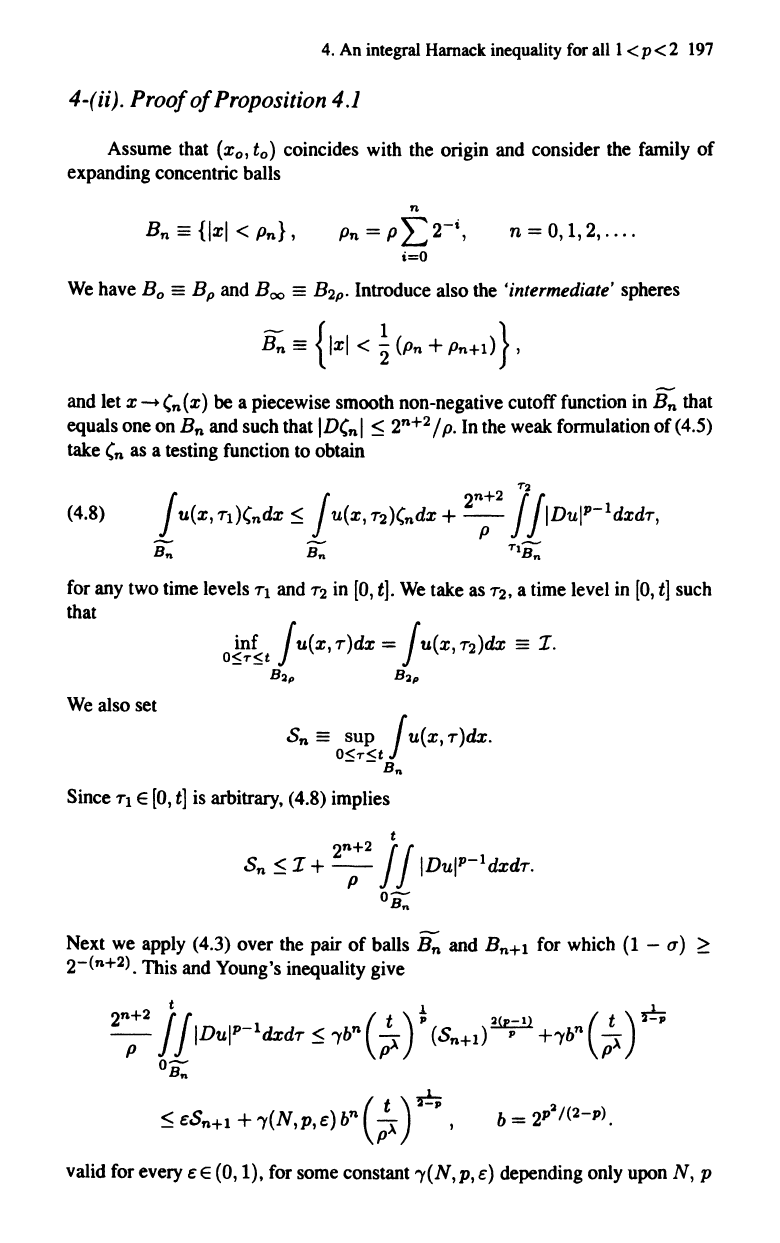
4.
An
integral Harnack inequality for all 1 < p < 2 197
4-0i). Proof
of
Proposition
4.1
Assume that
(X
o
,
to)
coincides with the origin and consider the family
of
expanding concentric balls
n
Pn
= P L
2
-
i
,
i=O
n =
0,1,2,
....
We have Bo
==
Bp and
Boo
==
B2p' Introduce also the 'intermediate' spheres
and let x
-+
'n
(x)
be
a piecewise smooth non-negative cutoff function in
Bn
that
equals one on
Bn
and such that
ID'nl
~
2
n
+
2
/
p.
In the weak formulation
of
(4.5)
take
'n
as a testing function to obtain
for any two time levels
'Tl
and'T2 in
[0,
tJ.
We
take as
'T2,
a time level in
[0,
tJ
such
that
We also set
Sn
==
sup
ju(x,
'T)dx.
O<T<t
- -
Bn
Since'Tl E
[0,
tJ
is arbitrary, (4.8) implies
Next we apply
(4.3) over the pair
of
balls
Bn
and
BnH
for which
(1
- u)
~
2-(n+2). This and Young's inequality give
t
.1
6
2n;2
j jIDuIP-1dxd'T
~
",b
n
(;)
P
(SnH)
2(,;1)
+",b
n
(;l)
-P
0-
Bft
(
t)J!;
~eSnH+",(N,p,e)bn
pl
'
valid for every
eE
(0, I), for some constant
",(N,p,
e) depending only upon
N,
p
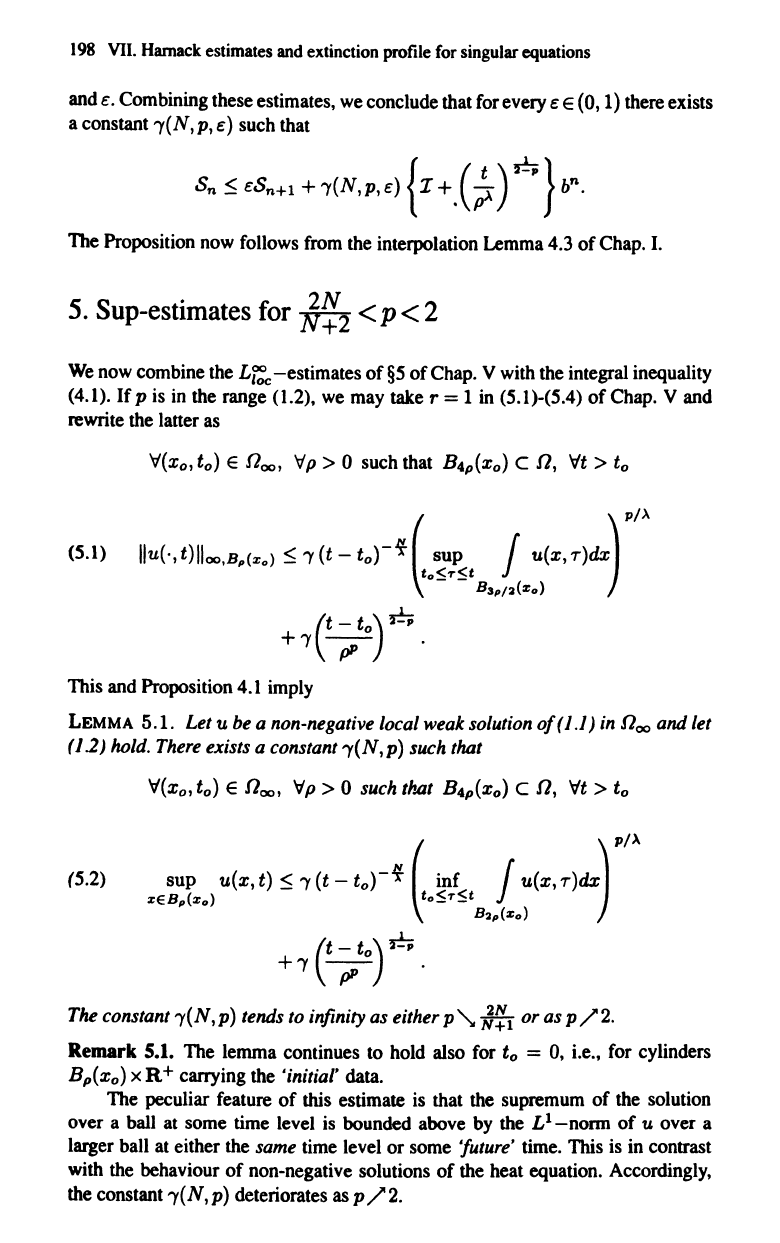
198
VII.
Harnack
estimates
and
extinction profile
for
singular
equations
and
E. Combining these estimates,
we
conclude that
for
every E E (0,1) there exists
a constant
'Y(
N, p,
E)
such that
s..
!>
<Sft+! + 1(N,p,<)
{z
+.(~)
r-.}
b".
The Proposition
now
follows
from
the
interpolation
Lemma
4.3 of
Chap.
I.
5.
Sup-estimates
for
&~2
< p < 2
We
now
combine
the
Ll::
-estimates of
§5
of
Chap.
V
with
the integral inequality
(4.1).
If
p
is
in
the range (1.2),
we
may
take r = 1
in
(5.1)-(5.4)
of
Chap. V and
rewrite the latter
as
(5.1)
lIu(·,
t)lIoo,Bp(zo)
~
'Y
(t -
to)-~
( sup J u(x,
T)dx~
pI)..
to~.,.~t
B
Sp
/
2
(zo)
+'YC~to)
~.
This and Proposition 4.1
imply
LEMMA 5.1. Let u
be
a non-negative local weak solution
of
(1.1)
in
noo
and let
(1.2)
hold.
There
exists a constant 'Y(N,p) such that
V(xo,
to)
E n
oo
,
Vp>
° such that
B4p(X
o
)
c
n,
"It>
to
(5.2) sup u(x, t)
~
'Y
(t -
to)-~
(inf
J u(x,
T)dx~
pI"
zeBp(zo)
to~"'9
B2p(Zo)
+'Y
e~to)~.
The
constant
'Y(
N,
p) tends to infinity as either p
'\,
J~
1 or as p /
2.
Remark
5.1. The lemma continues
to
hold
also
for
to
=
0,
i.e.,
for
cylinders
Bp(x
o
)
x
R+
carrying the 'initial' data.
The peculiar feature
of
this estimate
is
that
the
supremum of the solution
over a
ball
at
some
time
level
is
bounded above
by
the
Ll-nonn
of
u over a
larger ball
at
either
the
same
time
level or some 1uture'
time.
This
is
in
contrast
with the behaviour of non-negative solutions
of
the heat equation. Accordingly,
the
constant
'Y(
N, p) deteriorates
as
p /
2.
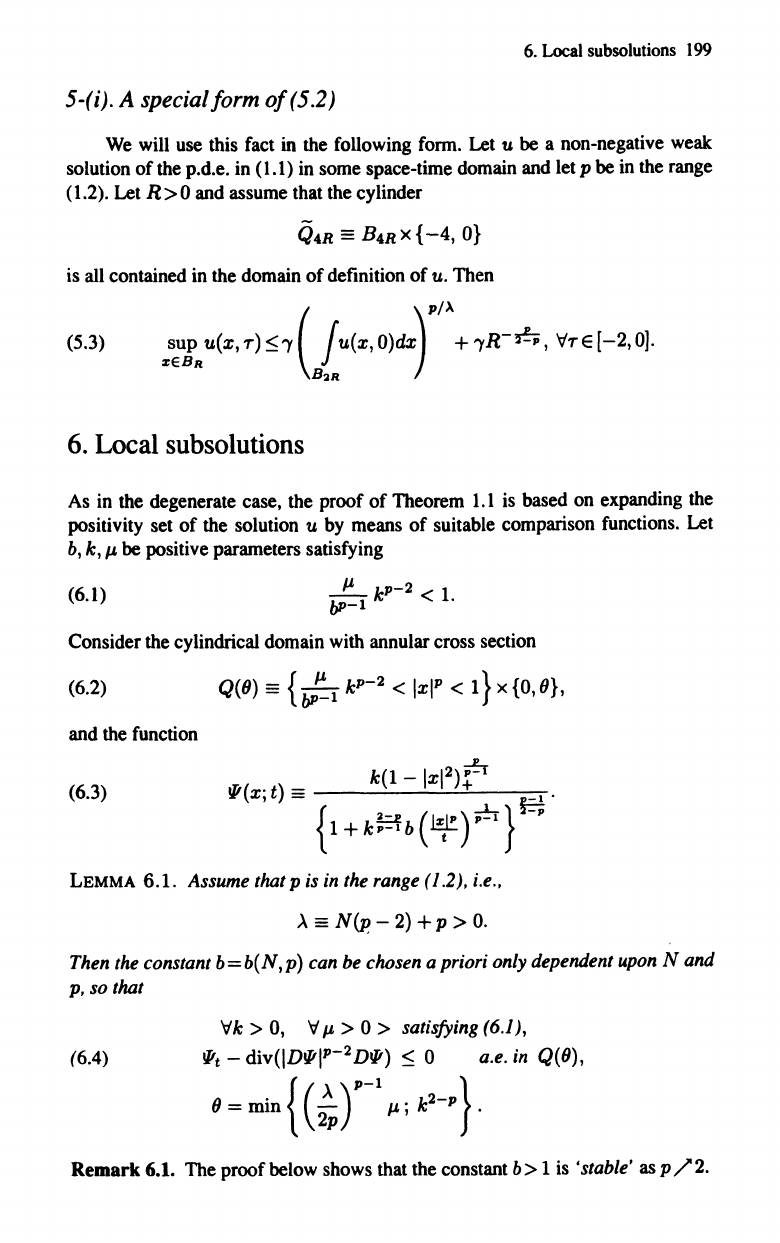
6.
Local
subso1utions
199
5-(i). A special/orm 0/(5.2)
We will use this fact in the following form. Let u be a non-negative weak
solution
of
the p.d.e. in (1.1) in some space-time domain and let p be in the range
(1.2). Let
R>O
and assume that the cylinder
Q4R
==
B4RX{-4,
O}
is all contained in the domain
of
definition
of
u.
Then
6. Local subsolutions
As in the degenerate case, the proof
of
Theorem
1.1
is based on expanding the
positivity set
of
the solution u by means
of
suitable comparison functions. Let
b,
k,
JL
be positive parameters satisfying
(6.1)
Consider the cylindrical domain with annular cross section
(6.2)
Q(8)
==
{:-1
k
P
-
2
<
Ixl
P
<
I}
X
{O,8},
and the function
(6.3)
LEMMA 6.1. Assume that p
is
in
the
range (1.2), i.e.,
A
==
N(P
-
2)
+ p >
O.
Then
the
constant
b=b(N,p)
can
be
chosen a priori only dependent
upon
Nand
p,
so
that
Vk
> 0, V
I'
> 0 > satisfying (6.1),
(6.4)
Wt
- div(lDwl
p
-
2
Dw)
~
0
a.e.
in
Q(8),
8=min{
(~)P-l
JLj
k2-P}.
Remark
6.1. The proof below shows that the constant b> 1 is • stable' as p / 2.
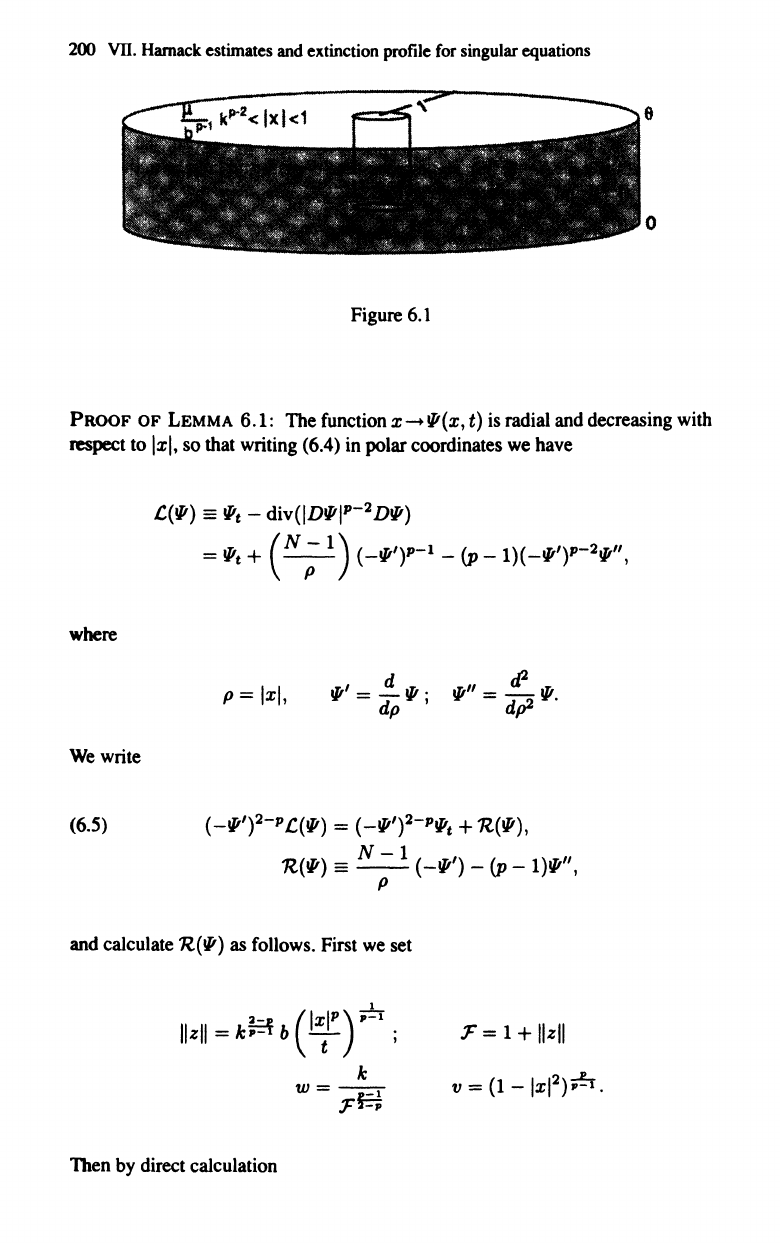
200
YD.
Harnack
estimates
and
extinction profile
for
singular equations
e
o
Figure
6.1
PROOF
OF
LEMMA 6.1: The function
x-!li(x,t}
is
radial and decreasing with
respect to
Ixl.
so that writing (6.4) in polar coordinates
we
have
where
We
write
C(!Ii}
==
!lit - div(ID!liI,,-2 D!Ii}
= !lit + ( N ;
1)
(_!li,},,-l _ (p _ 1)( _!li,),,-2!1i",
p=lxl,
!Ii' =
~!Ii
;
dp
(6.5) ( _!li,)2-"
C(!Ii)
= (_!li,)2-"!lit +
'R.(!Ii)
,
'R.(!Ii)
==
N - 1
(-!Ii')
- (p - 1 } !Ii" ,
p
and calculate
'R.(!Ii)
as
follows. First
we
set
~
(IXI")~
IIzll
=kFIb
-t
;
F = 1 +
IIzll
k
W=--l
FF-;
11
=
(1
-lxI
2
);!r.
Then by direct calculation
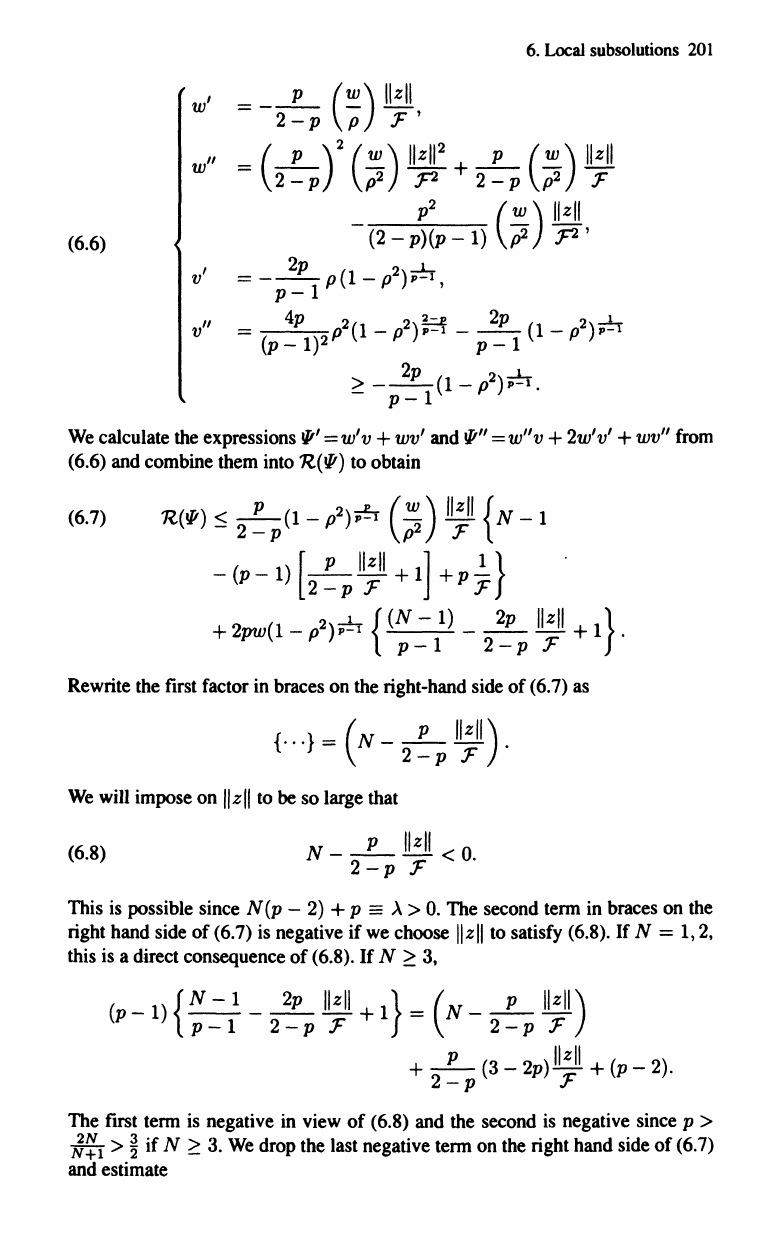
6. Local subsolutions
201
(6.6)
We calculate the expressions
1/1'
=
w'v
+
wv'
and
1/1"
=
w"
v + 2w'v' +
wv"
from
(6.6) and combine them into
'R.(I/I)
to obtain
(6.7)
'R.(I/I)
:5
-P-(I
-
p2);;!-r
(w)
M
{N
- 1
2-p
p2
:F
- (p -
1)
- - + 1 +
p-
[
P
IIzll
] 1 }
2-p:F
:F
+
2pw(I-
p2)~
{(N
-
1)
_
~
M +
I}.
p-I
2-p:F
Rewrite the first factor in braces on the right-hand side
of
(6.7) as
{
...
}=(N--
P
M).
2-
p
:F
We
will impose on
/I
z
II
to
be
so
large that
(6.8)
N-_p_M<o.
2
-p
:F
This is possible since N(p - 2) + p
==
A>
O.
The second term in braces on the
right hand side
of
(6.7) is negative
if
we choose
IIzll
to satisfy (6.8).
If
N =
1,2,
this is a direct consequence
of
(6.8).
If
N
~
3,
(P_I){N-I
_
~M
+I}
=
(N-
_P_
M)
p-I
2-p:F
2-p
:F
+
-p-
(3
-
2p)M
+
(p-
2).
2-p
:F
The first term is negative in view
of
(6.8) and the second is negative since p >
;:~l
>
~
if
N
~
3. We drop the last negative term
on
the right hand side
of
(6.7)
and estimate
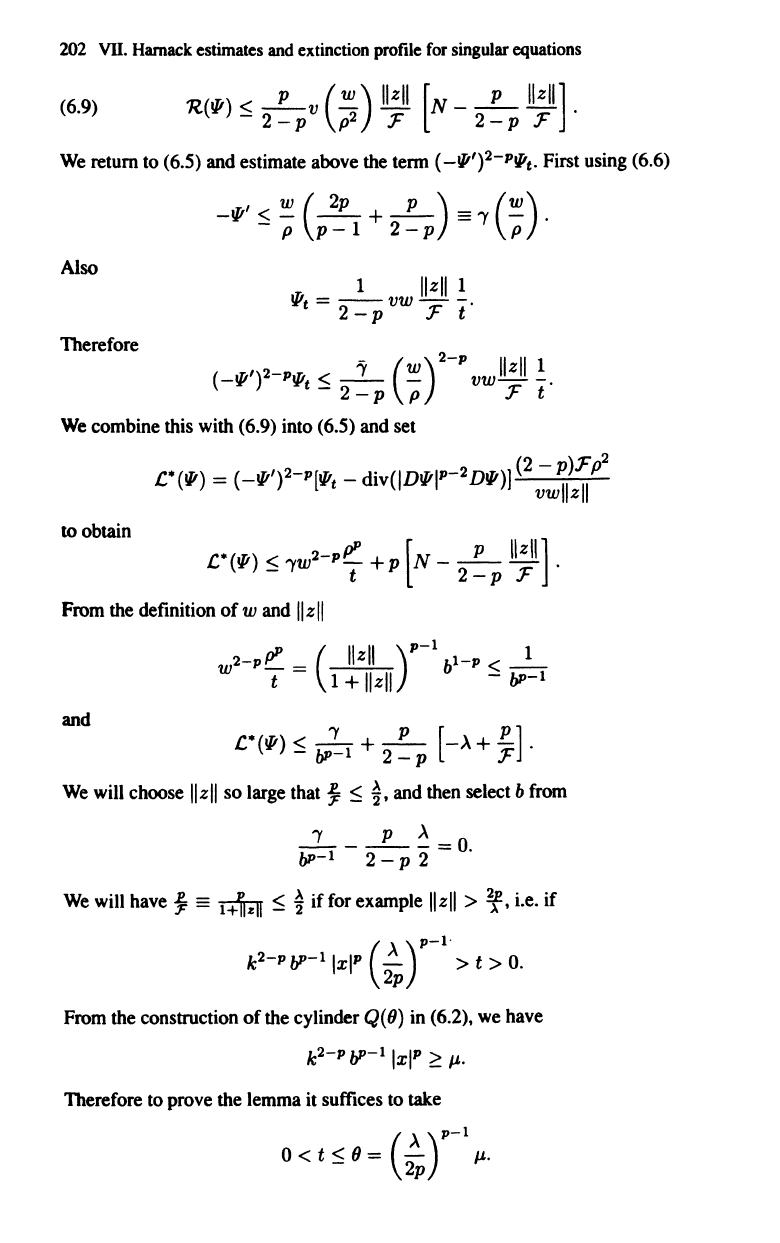
202
VII.
Harnack
estimates
and
extinction profile
for
singular equations
(6.9)
'R.(lli)
~
_P-v (
W)
J!.:!l
[N
_ _
P_
J!.:!l]
.
2-p
p
2
:F
2-p
:F
We return
to
(6.5) and estimate above the term ( -lli,)2-"lli
t
•
First using (6.6)
, w ( 2p
p)
(w)
-lli
~
P p _ 1 + 2 _ p
==
'Y
P .
Also
lli
t
=
_1_
vw
J!.:!l
~.
2-p
:F
t
Therefore
(-lli')2-"lli
t
~
~
(~)2-"
vw.ll:l!.~.
2-p
p
:F
t
We combine this with (6.9) into (6.5) and set
to obtain
C*(lli) =
(-lli')2-"[lli
t
_
div(lDllil,,-2 Dlli)]
(2
- p):F
p2
vwllzll
C*(lli)
~
'YW2-"pP
+ P
[N
-
-p-
.ll:l!.]
.
t
2-p
:F
From the defmition
of
w and
II
z
II
w
2
-"pP
= (
IIzll
),,-1
6
1
-"
<
_I_
t 1 +
IIzll
-
11'-1
and
.c*(lli) < ...:L +
_P_
[-,\
+
1!..]
.
-
11'-1
2 - P
:F
We will choose
II
z
II
so
large that
~
~
~,and
then select 6 from
'Y
p'\
-----=0
11'-1
2 - P 2 .
We will have
~
==
I41T
~
~
if
for example
IIzll
>
¥,
i.e.
if
k
2
-"
V-I
Ixl"
(~)
,,-1'
> t >
O.
From the construction
of
the cylinder
Q(
fJ)
in
(6.2),
we
have
k
2
-"
V-I
Ixl"
~
",.
Therefore
to
prove the lemma
it
suffices to take
(
,\),,-1
o < t
~
fJ
= 2p
",.
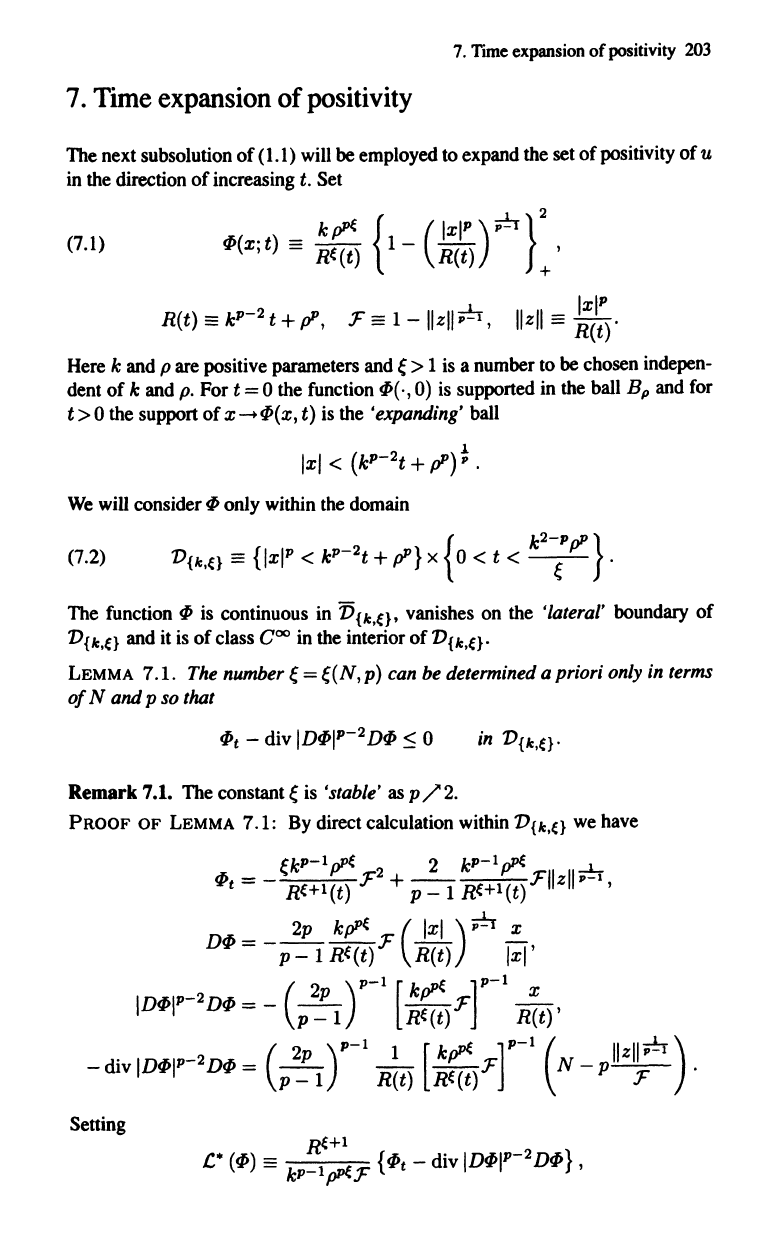
7.
Time
expansion of positivity
203
7.
Time expansion of positivity
The next subsolution
of
(1.1) will be employed to expand the set
of
positivity
of
u
in the direction
of
increasing
t.
Set
(7.1)
k~
{ (
Ix
I"
);2:r}2
~(x;t)
==
Re(t)
1-
R(t)
+'
R(t)
==
k
P
-
2
t +
pP,
F
==
l-lIzlI;2:r,
IIzll
==
:(1:).
Here k and p
are
positive parameters and
e>
1 is a number to be chosen indepen-
dent
of
k and
p.
For t = 0 the function
~(.,
0) is supported in the ball B p and for
t > 0 the support
of
x-~(x,
t)
is the 'expanding' ball
We
will consider
~
only within the domain
The function
~
is continuous in V{k,e}. vanishes on the 'lateral' boundary
of
V{k,e} and it is
of
class
Coo
in the interior ofV{k,e}.
LEMMA
7.1. The number e =
e(
N,
p) can be determined a priori only in terms
of
N
and
p so that
Remark
7.1. The constant e is 'stable' as p
/'
2.
PROOF
OF
LEMMA
7.1: By direct calculation within V{k,e} we have
ek"-l~
2 2
k"-l~
-L
~t
= - Re+l(t) F +
p-l
~+l(t)Fllzllp-l,
2p
k~
(IXI);2:r x
D~=
-
p-l
~(t)F
R(t) lxi'
ID~I,,-2D~
= _
(~)P-l
[k~
F],,-l
-=-
p - 1 Re(t)
R(t)
,
-div
1~1,,-2D~
=
(~)"-l
_1
[k~
F]"-l
(N
_
pIlZII;2:r)
.
p-l
R(t)
~(t)
F
Setting
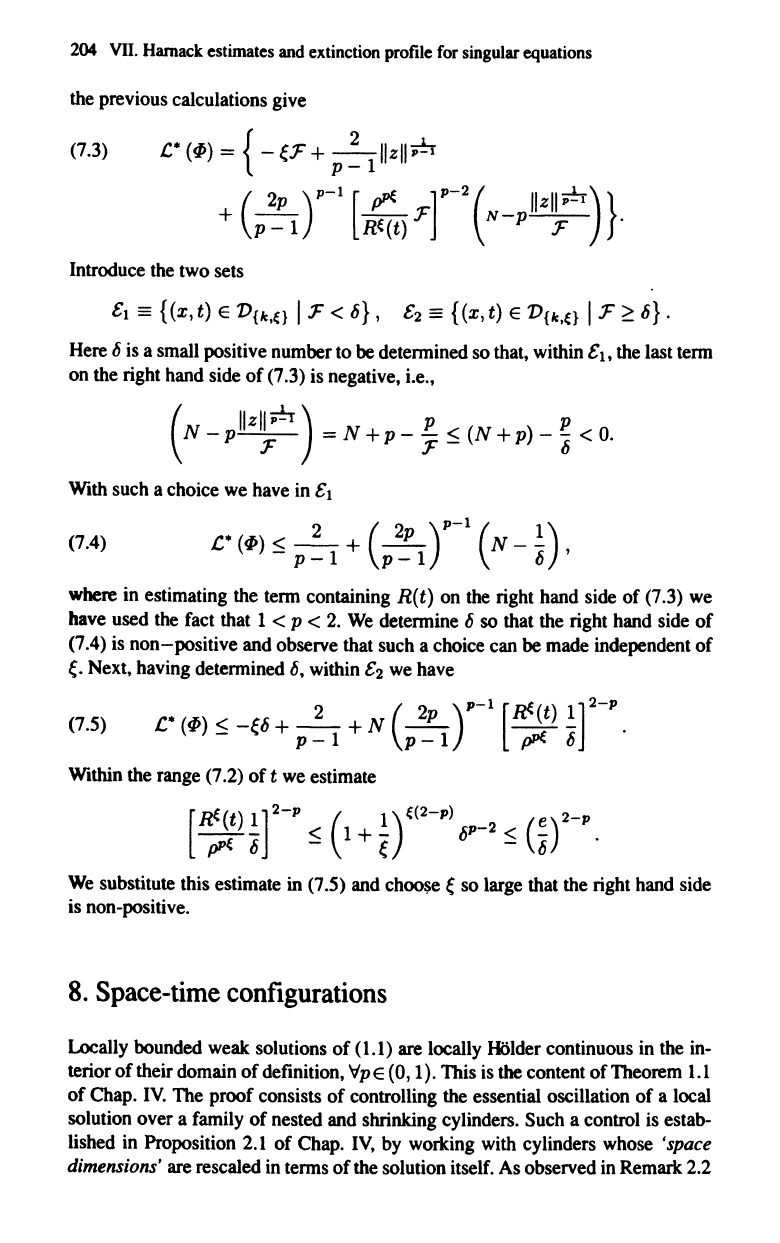
204
VU.
Harnack
estimates
and
extinction profile
for
singular equations
the previous calculations give
(7.3)
C·
(4))
=
{-
f.F +
_2_lIzll~
p-l
(
~)P-l
[~
]p-2(
_
IIZIl~)}
+ p _ 1
R£.(t)
F N P F .
Introduce the two sets
£1
==
{(X,t) E
V{k.£.}
I:F
< 6},
£2
==
{(X,t) E
V{k.£.}
I F
~
6}.
Here 6 is a small positive number to be determined so that, within
£1,
the last term
on
the right hand side
of
(7.3) is negative, i.e.,
With such a choice we have in
£1
(7.4)
c-
(4))
~
_2_
+
(~)p-l
(N
_
~)
,
p-l p-l
6
where in estimating the term containing R(t)
on
the right hand side
of
(7.3) we
have used the fact that 1
< p <
2.
We
determine 6 so that the right hand side
of
(7.4) is
non-positive
and observe that such a choice can
be
made independent
of
f..
Next, having determined 6, within
£2
we have
(7.5)
c-
(4))
~
-f.6 +
_2_
+ N
(~)p-l
[nt.(t)
~]2-p
p-l
p-l
pPt.
6
Within
the
range (7.2)
of
t we estimate
[
nt.(t)
1]2-1'
(
1)£.(2-1')
-2
(e)2-p
---
< 1 + -
61'
< - .
,.6
-
f.
-6
We
substitute this estimate in (7.5) and
choo~e
f.
so large that the right hand side
is non-positive.
8.
Space-time configurations
Locally bounded weak solutions
of
(1.1) are locally
R;Ider
continuous in the in-
terior
of
their domain
of
definition, "ripE (0,1). This is
the
content
of
Theorem 1.1
of
Chap.
IV.
The proof consists
of
controlling the essential oscillation
of
a local
solution over a family
of
nested and shrinking cylinders. Such a control is estab-
lished in Proposition 2.1
of
Chap.
IV,
by working with cylinders whose 'space
dimensions' are rescaled in terms
of
the solution itself. As observed in Remark 2.2
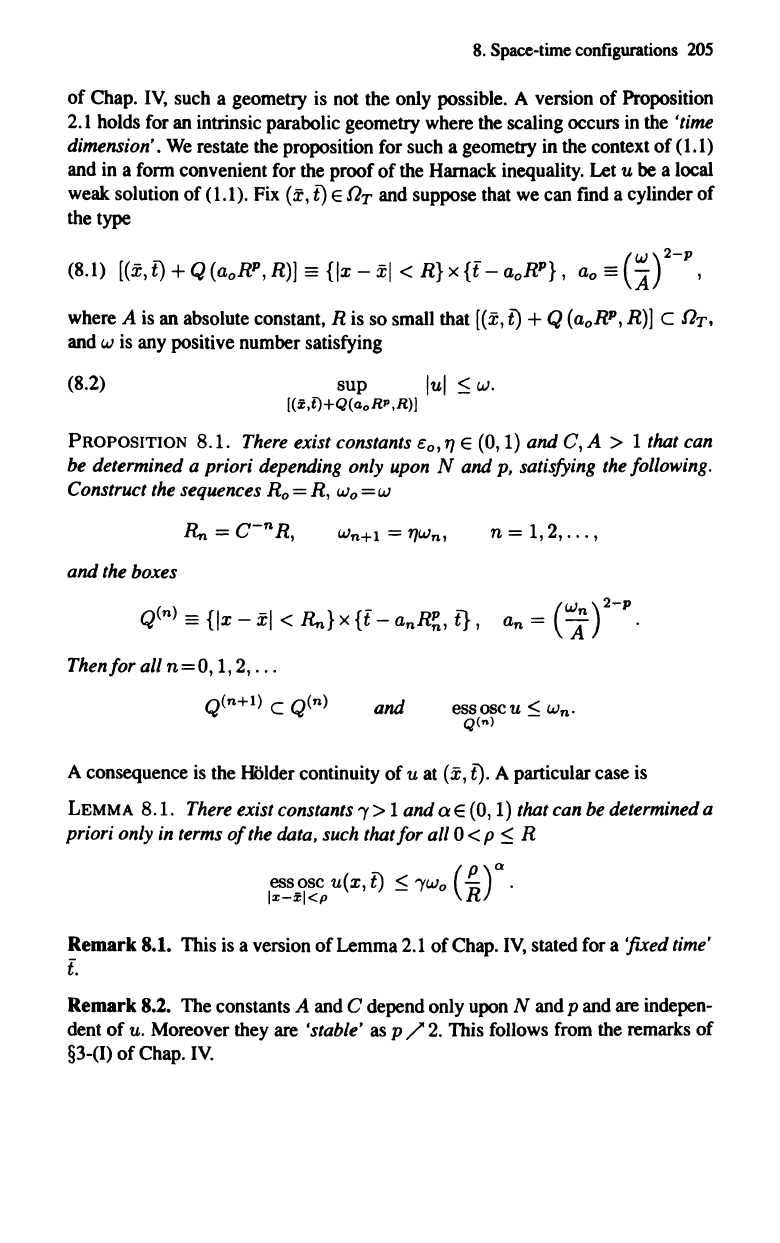
8.
Space-time
configurations
205
of Chap.
IV,
such a geometry is not the only possible. A version of Proposition
2.1 holds for
an
intrinsic parabolic geometry where the scaling occurs
in
the 'time
dimension'.
We
restate the proposition for such a geometry
in
the context of (1.1)
and
in
a
form
convenient for the proof of
the
Harnack inequality. Let
1.£
be
a local
weak solution of
(1.1). Fix (x, t) E n
T
and
suppose that
we
can
fmd
a cylinder of
the type
(8.1)
[(x,
t) + Q (aoR",
R)]
==
{Ix -
xl
<
R}
x
{l-
aoR"} , a
o
==
(~)
2-",
where A
is
an absolute constant, R is so small that
[(x,
t) + Q (aoR",
R)]
c
nT,
and w
is
any
positive number satisfying
(8.2)
sup
11.£1
:5
w.
[(z,l)+Q(ooRr>
,R)]
PROPOSITION
8.1. There exist constants eo,
1/
E (0,1)
and
C, A > 1 that can
be determined a priori depending only upon N and p, satisfying the following.
Construct the sequences
Ro =
R,
WO
= W
Rn
=C-nR,
Wn+l =
TJWn,
n = 1,2,
...
,
and the boxes
_
(
Wn)2-"
Q(n)
==
{Ix -
xl
<
Rn}
x
{l-
anR~,
l},
an
- A .
Thenfor all
n=O,
1,2,
...
and
essosc
1.£
:5
W
n
·
Q(n)
A consequence
is
the
HOlder
continuity of
1.£
at (x, t). A particular case
is
LEMMA
8.1. There exist constants
"'(
> 1
and
a E (0,
1)
that can be determined a
priori only in terms
of
the data, such that for all
0<
p
:5
R
essosc u(x, t)
:5
"'(Wo
(RP)Q
.
Ix-zl<p
Remark
8.1. This
is
a version of Lemma
2.1
of Chap.
IV,
stated for a 'fixed time'
l.
Remark
8.2. The constants A and C depend only
upon
N and p and
are
indepen-
dent
of
u.
Moreover they
are
'stable'
as
p
/2.
This follows
from
the remarks of
§3-(I) of Chap.
IV.
